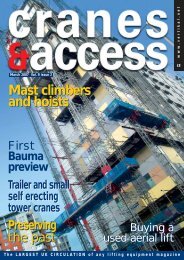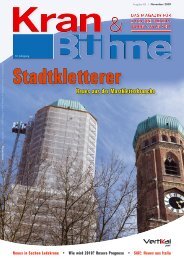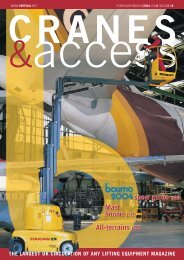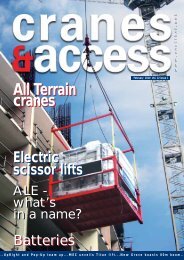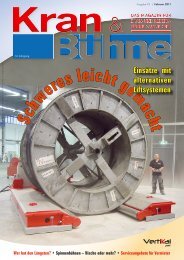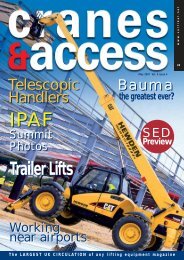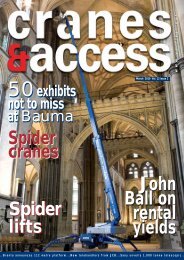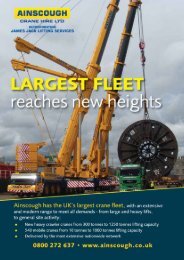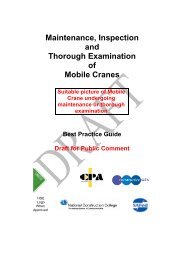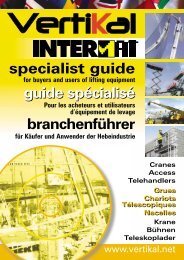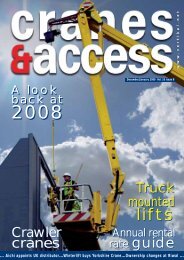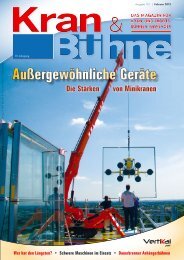AT boom lifts c&a - Vertikal.net
AT boom lifts c&a - Vertikal.net
AT boom lifts c&a - Vertikal.net
You also want an ePaper? Increase the reach of your titles
YUMPU automatically turns print PDFs into web optimized ePapers that Google loves.
The<br />
permanent nt<br />
niche<br />
machine<br />
Imagine a self-propelled <strong>boom</strong> lift with working<br />
heights of up to 27 metres, that is less than half the<br />
weight and considerably faster than conventional<br />
<strong>boom</strong>s, offers gradeability of up to 45 percent, can<br />
automatically level up and work on slopes, yet<br />
does not employ a tracked undercarriage do you<br />
think it would be a winner? After all the cost of<br />
transportation, traversing soft ground without having<br />
to put in expensive temporary roads, concern over<br />
surface damage to pavements and increasingly<br />
critical floor loadings are all becoming major issues<br />
on sites and in other places that aerial <strong>lifts</strong> are<br />
being used.<br />
Well, there is such a product - the<br />
All Terrain, Semi Self-Propelled or<br />
Self Drive platform. The fact that<br />
there is no clear industry name<br />
for this category illustrates its<br />
lack of widespread popularity.<br />
Quite why this extremely capable<br />
and useful platform type has<br />
never captured the imagination<br />
of rental companies or end users<br />
is something of a mystery and so<br />
it has remained a niche product<br />
for all of its almost 30 year’s<br />
existence.<br />
Despite having being around in one<br />
form or another since the late<br />
1970s, limited demand means only<br />
a few manufacturers include such a<br />
product in their line-ups, resulting in<br />
relatively low annual sales. Could<br />
this be another case of rental<br />
companies following the market like<br />
sheep, rather than introducing their<br />
customers to alternative and<br />
possibly better solutions to their<br />
access problems? Cranes & Access<br />
takes a look at the development of<br />
the <strong>AT</strong>/SD sector, the products<br />
currently available and tries to<br />
answer that question.<br />
The first All Terrain type selfpropelled<br />
<strong>lifts</strong> were just what the<br />
name suggests and used a rugged<br />
4x4 chassis from that peculiarly<br />
British, go anywhere ‘site dumper’<br />
built by manufacturers such as<br />
Benford, Winget, Thwaites and<br />
others. Mounting an articulated<br />
<strong>boom</strong> - usually sourced from a<br />
trailer lift - in place of the normal<br />
material skip, resulted in a light,<br />
speedy, platform that could travel<br />
over almost any terrain. And all but<br />
the very earliest units had the<br />
facility to level the chassis using<br />
four outriggers.<br />
The initial machines were in fact<br />
quite popular, possibly due to the<br />
fact that they appealed to general<br />
rental companies who in those days<br />
bought large numbers of dumpers,<br />
so they understood the technology,<br />
as did contractors. This combined<br />
with the growing popularity of<br />
powered access rental, then still<br />
in its infancy in Europe, helped<br />
boost sales in what was then a<br />
much smaller market. Design<br />
developments and improvements<br />
through the 1980s saw the<br />
c&a<br />
introduction of more suitable 4x4<br />
chassis, either using the longer<br />
wheelbase dumpers coming on the<br />
scene at that time or by building the<br />
drive line components into a<br />
purpose-built chassis frame. These<br />
units were also fitted with open,<br />
seated driving stations and<br />
producers included Pegasus (later<br />
Thwaites), Benford, Powered<br />
Access, Simon Aerials/Kombilift<br />
and Aerial.<br />
In the 1990’s the concept was<br />
refined still further with something<br />
of a split away from the dual control<br />
position machines with their<br />
dumper ge<strong>net</strong>ics towards the<br />
concept we see today. This was led<br />
by Finnish company Rotator/<br />
Scanlift. None of these brands have<br />
survived and today<br />
there are just five<br />
manufacturers<br />
offering this type<br />
of lift – Niftylift,<br />
Bil-Jax, Dinolift,<br />
Snorkel and<br />
Nostolift/Kesla.<br />
Stage one:<br />
The dumpers<br />
Benford and later<br />
Powered Access<br />
Ltd were among<br />
the first UK<br />
manufacturers to<br />
produce an <strong>AT</strong>/SD<br />
type platform. The<br />
RT46 was an early<br />
Powered Access<br />
platform using a<br />
modified dumper<br />
type chassis built<br />
by Ro-Terr-Tech of<br />
Gateshead. It was<br />
a simple articulated<br />
<strong>boom</strong> offering 14<br />
The Ro-Terr-Tech/Powered<br />
Access RT46 in 1991 -<br />
with Don Taylor of<br />
Powered Access and<br />
Greg McTigue of<br />
Ro-Ter-Tech<br />
<strong>AT</strong> <strong>boom</strong> <strong>lifts</strong><br />
metres working height and 6.2<br />
metres of outreach, with a high top<br />
speed of 35kph and a chassis<br />
mounted driving seat. An optional<br />
cab was also available for those<br />
who planned to use it on the road<br />
in winter. Platform capacity was<br />
215kg and it featured four<br />
outriggers which allowed the<br />
machine to be levelled up from the<br />
driver’s seat. A 50ft platform - 17<br />
metre working height model - the<br />
RT56 came later.<br />
Benford had started out with the<br />
simplest product of all, when it<br />
mounted a lightweight articulated<br />
trailer lift <strong>boom</strong> with one man<br />
platform to its standard two tonne<br />
capacity TS40 swing dumper<br />
chassis in place of the usual skip.<br />
October 2011 cranes & access 25
<strong>AT</strong> <strong>boom</strong> <strong>lifts</strong> c&a<br />
The resulting unit - the LM31D<br />
Liftmate - had a working height of<br />
9.5 metres. However in order to<br />
move the centre of gravity forward,<br />
chassis modifications - including<br />
using heavy steel plate for front<br />
fabrications such as mudguards -<br />
were needed. ‘Modern’ platform<br />
features included entrance into the<br />
basket at ground level and up to<br />
4.2 metres of outreach without<br />
stabilisers.<br />
In a report on the machine at the<br />
time Benford was quoted as saying<br />
that ‘stability is the most important<br />
safety aspect of any self-propelled<br />
aerial work platform’. It said that the<br />
LM31D was stable in all <strong>boom</strong><br />
positions on slopes of up to five<br />
degrees. The use of foam-filled<br />
puncture-proof front tyres further<br />
increased safety and a dual axis<br />
inclinometer was also fitted. The<br />
company said at the time that it<br />
was also considering a 12 metre<br />
version with a short third <strong>boom</strong> but<br />
this would require stabilisers. As far<br />
as we know it never saw the light<br />
of day, having been superseded by<br />
the Powered Access type product<br />
which was quickly trumped by units<br />
with telescopic <strong>boom</strong>s.<br />
26 cranes & access October 2011<br />
Rather than develop the dumper<br />
mounted concept Benford went on<br />
manufacturer to a wider range of<br />
access equipment, all built in the<br />
UK. Its line-up eventually included a<br />
popular range of self-propelled<br />
‘construction’ scissor <strong>lifts</strong> and the<br />
14 metre, zero tail swing LM46 selfpropelled<br />
<strong>boom</strong> which featured one<br />
of the first articulated jibs, which<br />
it referred to as a droop snoot.<br />
Meanwhile US-based Marklift,<br />
having acquired the Liner plant in<br />
the UK northeast, introduced the<br />
RT95 but the entire venture was<br />
short lived and few ever made it<br />
onto the market.<br />
The<br />
Marklift<br />
RT95<br />
Stage two:<br />
sophistication<br />
creeps in<br />
The<br />
Benford<br />
LM31<br />
Liftmate<br />
John Hocking - an<br />
engineer and early<br />
access industry<br />
innovator - also spotted<br />
the potential of the<br />
dumper-mounted lift<br />
and established the<br />
Pegasus company in<br />
1985 which operated<br />
out of a manufacturing<br />
facility in Hixon,<br />
Staffordshire.<br />
Remaining with the dumper concept<br />
and components, he used a longer<br />
wheelbase chassis which could<br />
travel at greater speeds and also<br />
level up on uneven ground. After<br />
producing around 200 platforms, the<br />
company ceased trading in 1990<br />
and the assets were purchased by<br />
leading dumper manufacturer<br />
Thwaites. The most popular model -<br />
the <strong>AT</strong>52T - had a purposedesigned,<br />
all-terrain chassis single<br />
stage riser and telescopic top<br />
<strong>boom</strong>.<br />
In spite of an unattractive<br />
dollar/sterling exchange rate at that<br />
time Thwaites saw the North<br />
American market as vital to its<br />
long-term sales success – the USA<br />
A Pegasus<br />
<strong>AT</strong>52 in<br />
the USA
The Pegasus <strong>AT</strong>52T<br />
after the Thwaites<br />
acquisition<br />
being the largest market in the<br />
world for self- propelled scissors<br />
and <strong>boom</strong>s. It was hoped that<br />
applications such as airport<br />
construction, commercial aircraft<br />
maintenance, petrochemical and<br />
refinery work - jobs where the<br />
distances were great and the high<br />
speed was a plus - would provide<br />
strong demand. However in spite of<br />
the obvious benefits that the<br />
Thwaites/Pegasus offered, most<br />
units were sold to rental companies<br />
with the long recession of the early<br />
to mid-1990s effectively killing the<br />
product off.<br />
Even 25 years ago, these early<br />
manufacturers recognised the<br />
limited mobility of most scissors<br />
and <strong>boom</strong>s both in speed and<br />
gradeability which is why machines<br />
such as the <strong>AT</strong>52T were popular. A<br />
combination of its 215kg capacity,<br />
34 kph travel speed, 30 percent<br />
gradeability, 16 metre (52ft)<br />
working height, outrigger levelling<br />
and gross vehicle weight of less<br />
than four tonnes gave it the<br />
versatility not available in other<br />
types of platform. It followed the<br />
concept at the time of site<br />
equipment being driven to site<br />
under its own steam, loader<br />
backhoes, telehandlers and<br />
products such as the Pegasus could<br />
all be made road legal and were<br />
regularly seen on the road travelling<br />
between job sites. Some of this<br />
was dictated by the fact that in the<br />
early days of powered access there<br />
were way too few dedicated<br />
delivery vehicles that could load and<br />
unload self–propelled platforms on<br />
site. There were low loaders of<br />
c&a<br />
course, but these were hugely<br />
expensive in comparison to two or<br />
three axle flatbed trucks and were<br />
only operated by specialist<br />
transport companies who knew<br />
how to charge.<br />
<strong>AT</strong> <strong>boom</strong> <strong>lifts</strong><br />
SD/<strong>AT</strong> products are light in<br />
comparison to other self-propelled<br />
<strong>boom</strong>s - note this 26.5 metre Dinolift<br />
on a flatbed truck, so easy to<br />
transport and place<br />
Around the same time as Hocking<br />
was working on the Pegasus,<br />
Powered Access of Market<br />
Harborough in the UK - the name<br />
which brought together a number of<br />
brand names including Acklift,<br />
October 2011 cranes & access 27
The Manhandler Roughneck made<br />
a big splash but never quite<br />
achieved its full potential<br />
Spencer and Armfield - introduced<br />
the 40ft platform height RT46<br />
mentioned earlier in this article and<br />
others soon joined these two. One<br />
of the most interesting was a<br />
product with a similar idea but<br />
different concept - the Manhandler<br />
designed by Bob Kinsey of<br />
Kombilift. The Manhandler ‘range’<br />
consisted of the ‘Aircruiser’ for the<br />
aircraft ground equipment market<br />
and the Roughneck 66 for<br />
construction applications. The<br />
Roughneck used a similar dumper<br />
type chassis concept with separate<br />
mid mounted driving position, but<br />
boasted a straight four section<br />
telescopic <strong>boom</strong> in place of the<br />
trailer derived articulated <strong>boom</strong>s of<br />
the others. It also used two large<br />
rear mounted A-frame outriggers in<br />
place of four. It boasted a 60ft<br />
platform height - 20 metres working<br />
height - which was a very popular<br />
<strong>boom</strong> size of at the time. It also had<br />
up to 13 metres of outreach and<br />
used a load management system it<br />
Simon acquired Kombilift<br />
and the Manhandler<br />
product<br />
called MaxiReach. The unit had an<br />
oscillating front axle which helped<br />
provide great rough terrain<br />
capability and speeds of up to<br />
24kph. The machine was heavier<br />
than the others at 4,800kg but still<br />
half the weight of the very lightest<br />
self-propelled <strong>boom</strong> available at the<br />
time. The company made a major<br />
push into the North American<br />
market, shipping demonstration<br />
units out, along with a young sales<br />
rep to tour rental companies and<br />
solicit orders. The anticipated US<br />
breakthrough never really happened<br />
and around 1989 the company and<br />
its products were acquired by<br />
Simon.<br />
Production of the Manhandler was<br />
transferred to the Simon Aerials<br />
plant in Thetford, Norfolk and the<br />
product - following a facelift - was<br />
added to the massive Simon<br />
product range of the time. In the<br />
land of their origin - the UK - the<br />
dumper-based units reached their<br />
zenith in the late 1980s and early<br />
1990’s when the access<br />
business was <strong>boom</strong>ing. The full<br />
line aerial lift producers from<br />
North America began to look at<br />
the category but then the<br />
recession of the early 1990s<br />
killed that off as new sales dried<br />
up. However rental rates for this<br />
type of lift held up through the<br />
slow-down, thanks to the<br />
platforms’ all terrain ability<br />
which found favour with users<br />
outside the construction<br />
industry, such as forestry,<br />
maintenance and inspection<br />
work. This remains the case<br />
today, however over the past 20<br />
years demand has never really<br />
taken off from the levels of the<br />
early 1990s, explaining perhaps<br />
for the relatively few<br />
manufacturers in the sector<br />
today.<br />
Stage three:<br />
The modern<br />
era<br />
c&a<br />
If you look at<br />
those that remain<br />
in the market,<br />
one thing jumps<br />
out (apart from<br />
the almost<br />
defunct Kesla,<br />
now Nostolift)<br />
all are<br />
principally trailer<br />
lift producers.<br />
The trailer lift<br />
<strong>boom</strong> with its offset slew ring,<br />
lends itself to mounting on an all<br />
terrain chassis, allowing such<br />
companies to produce a<br />
self-propelled <strong>boom</strong> lift without<br />
committing to a totally new design.<br />
While some think of these<br />
machines as a quintessentially<br />
British product, the modern allterrain<br />
arguably hails from Finland<br />
where in 1991 forestry equipment<br />
manufacturer Kesla introduced an<br />
18 metre working height telescopic<br />
<strong>boom</strong> lift on a 4x4 all terrain<br />
chassis, calling it the Scanlift<br />
SL180, which became the 18.5<br />
metre SL185 after production began<br />
in 1992. Some of the first units<br />
were sold in Holland and sensing<br />
their might be some overseas<br />
potential the company signed an<br />
agreement with a major access<br />
equipment distributor Rotator Oy -<br />
which also handled JLG. In the mid<br />
1990’s 24 and 32 metre models<br />
were added to the range, although<br />
the 32 may not have made it onto<br />
the open market? A year or so later<br />
the company took back the<br />
distribution rights and then several<br />
years later when it introduced up<br />
dated and more reliable versions it<br />
chose to completely rebrand them<br />
as Kesla <strong>lifts</strong>. The Kesla XS range is<br />
still built in tiny volumes by Finish<br />
based Nostolift. Scanlift was joined<br />
<strong>AT</strong> <strong>boom</strong> <strong>lifts</strong><br />
The Scanlift became the Kesla lift with two models,<br />
the XS190 and the XS240<br />
in 2006 by fellow Finn Dinolift,<br />
making this a distinctly Finnish<br />
market sector.<br />
Danish neighbour Denka also took a<br />
stab at the market in the mid 1990’s<br />
with its 23 metre telescopic<br />
RST2300 model developed in<br />
partnership with its German<br />
distributor Rothlehner and<br />
manufacturer PB. While a few units<br />
were built the product never gained<br />
standard product status.<br />
Back in the UK, Milton Keynes<br />
based Niftylift was approached in<br />
1995 by its Dutch distributor<br />
Eurosupply to design a machine for<br />
construction work on the major<br />
Schiphol expansion project that was<br />
being planned. The contractor was<br />
looking for a 17 metre working<br />
height self-propelled <strong>boom</strong> lift that<br />
was lightweight and that could<br />
spread its weight over a wide area<br />
to meet tight floor loading<br />
challenges. Using the Nifty 170<br />
trailer lift superstructure the two<br />
developed a special that was later<br />
developed into the SD170 = 17<br />
metre Self-Drive. Since then<br />
customer demand has caused it to<br />
add a larger and more recently a<br />
smaller machine to its line-up to<br />
create its current three model SD<br />
range and the company is now one<br />
of the leading manufacturers along<br />
with Dinolift.<br />
The Rohlehner/Denka RST2300<br />
October 2011 cranes & access 29
<strong>AT</strong> <strong>boom</strong> <strong>lifts</strong> c&a<br />
The Nifty 170<br />
was designed<br />
in 1995 and is<br />
the company’s<br />
most popular<br />
SD model<br />
The Nifty SD210 handles soft<br />
ground with ease thanks to<br />
its large turf tyres<br />
The Niftylift 170 is the company’s<br />
most popular SD model. “Users like<br />
the quick travel speed and low<br />
ground pressure of the SD<br />
platforms,” says Niftylift managing<br />
director John Keely. “Tracked<br />
machines have problems with<br />
weight, stability on steep ground,<br />
travel speed and surface damage so<br />
for numerous applications the SD is<br />
the best solution and is particularly<br />
popular with tree surgeons and for<br />
use on large estates.”<br />
One major design difference<br />
between the all-terrain products<br />
produced today and the original<br />
machines is that all modern<br />
platforms are driven from the<br />
basket. Early designs - particularly<br />
those based on site dumpers - used<br />
the chassis’ operator’s seat and<br />
controls, the high - 20kph plus -<br />
travel speed has also gone. The one<br />
exception to this is the dumper<br />
based Snorkel which is still<br />
produced to order.<br />
Each of Niftylift’s three models adds<br />
something different to its SD<br />
concept. The smallest, the SD120T<br />
uses the articulated lift mechanism<br />
- single riser and telescopic upper<br />
<strong>boom</strong> - from its very popular HR12<br />
30 cranes & access October 2011<br />
The Nifty SD120T<br />
Unlike most of<br />
the products<br />
on the market<br />
the Niftylift<br />
SD210 has spring<br />
suspension<br />
fully self-propelled <strong>boom</strong> lift and<br />
T120T compact trailer lift. It offers a<br />
12.65 metre working height and 6.1<br />
metres of outreach yet weighs just<br />
2,260kg.<br />
The larger 17.1 metre working<br />
height SD170 has the same<br />
performance as the company’s 170<br />
trailer lift, in terms of working<br />
height and its 8.7 metres of<br />
outreach, but with a driveable 4x4<br />
chassis. At 2,750kg it is two tonnes<br />
lighter than Niftylift’s HR17 Hybrid<br />
fully self-propelled <strong>boom</strong> lift and<br />
over half the weight of most 50ft<br />
<strong>boom</strong> <strong>lifts</strong> on the market.<br />
The largest model in the range - the<br />
SD210 4x4x4 - is a totally different<br />
beast and according to Nifty, the<br />
‘ultimate’ SD/<strong>AT</strong>, featuring fully<br />
independent suspension with four<br />
wheel drive and four wheel steer.<br />
When fitted with turf tyres the unit<br />
can easily travel over sensitive<br />
ground without damage thanks to<br />
its larger tyres, suspension and low<br />
gross vehicle weight of just 3,950kg<br />
almost half that of any articulated<br />
self-propelled <strong>boom</strong> on the market.<br />
Yet it can comfortably travel at<br />
speeds of up to 7.5kph and climb<br />
slopes of up to 45 percent. It offers<br />
21.3 metres of working height (64ft<br />
platform height) with 12.6 metres of<br />
outreach, 7.5 metres of up-and-over<br />
reach and the versatility of a 150<br />
degree articulating jib, not to<br />
mention standard platform rotation.<br />
The two smaller Niftylift SD<br />
machines have full hydraulic<br />
controls, levelling outriggers and are<br />
available with petrol, diesel, battery<br />
and Bi-Energy power, making them<br />
ideal indoor/outdoor machines as<br />
well as for working in sensitive<br />
areas such as private homes or<br />
hospitals etc.<br />
Back to the past<br />
As we have already mentioned<br />
Snorkel still has an <strong>AT</strong> platform in<br />
its range, although it’s AB48HSRT is<br />
now only built to special order. The<br />
platform (previously the UpRight<br />
AB48HSRT) is based on the Aerial<br />
Pioneer AD17T which used the<br />
Aerial K17 articulated telescopic<br />
trailer lift <strong>boom</strong> with 130 degree<br />
articulated jib, mounted on a<br />
bespoke chassis using an Ausa<br />
dumper drive train. The unit is built<br />
like a tank with short chunky heavy<br />
duty chassis and large box section<br />
A-frame outriggers. It offers a 49ft<br />
platform height – 16.8 metres of<br />
working height - with almost eight<br />
metres of outreach yet its gross<br />
vehicle weight is just 3,500kg and<br />
when set up on outriggers it has a<br />
footprint similar to many fully selfpropelled<br />
<strong>boom</strong> <strong>lifts</strong> at 2.4 metres<br />
The Snorkel<br />
AB46HSRT is based<br />
on the Aerial Pioneer<br />
AD17T and is the only<br />
machine left with<br />
dumper DNA<br />
wide. Unlike all the other all terrain<br />
<strong>lifts</strong> on offer it has a four speed<br />
dumper type transmission and can<br />
travel at 22kph and can be made<br />
fully street legal.<br />
Where it falls down though is on<br />
price and complexity, making it<br />
more suited to specific applications.<br />
An American entrant<br />
The most recent entrant in to this<br />
market is North American-based<br />
Bil-Jax, now part of Haulotte,<br />
having joined the market at the start<br />
of 2007. It has a three model line-up<br />
- two with articulated <strong>boom</strong>s and<br />
jibs and one straight telescopic. Its<br />
units are particularly light weight,<br />
simple yet rugged machines with a<br />
good specification. Prior to the<br />
company’s acquisition by Haulotte<br />
Bil-Jax had launched what it calls<br />
its X range in Europe and had done<br />
well with it, particularly in Germany.<br />
Its telescopic model the 37ft<br />
platform /13.2 metre working height<br />
36XT is a particularly attractive unit<br />
(in performance terms - not<br />
aesthetically), with almost 10<br />
metres of outreach and yet<br />
weighing just 2,300kg. The 4x4 unit<br />
was originally gas powered, but<br />
now comes with a battery electric<br />
power pack, making it very<br />
attractive for working around family<br />
homes etc.<br />
The two articulated models are both<br />
larger, the 45ft platform height<br />
45XA and 55ft – 18.7 metre
<strong>AT</strong> <strong>boom</strong> <strong>lifts</strong> c&a<br />
The Bil-Jax 36XT demonstrates how this type<br />
of lift easily copes with soft ground....<br />
The Bil-Jax 55XA<br />
working height 55XA has, we<br />
understand that the latter unit has<br />
been less successful than the other<br />
two and may be in the process of<br />
being phased out? All units include<br />
articulating axles and fast auto<br />
levelling outriggers.<br />
Back in Europe and moving north,<br />
there are, as we have said two<br />
Nordic producers both based in<br />
Finland - Dinolift which has three<br />
models and Nostolift – which<br />
acquired Kesla Oyj and the trade<br />
names of Scanlift and Kesla XS -<br />
with two models.<br />
Dinolift and Niftylift are the only<br />
companies left in the market with<br />
any serious volume, at least in<br />
Europe. Dinolift’s RXT models are all<br />
over 20 metres and so dovetail<br />
32 cranes & access October 2011<br />
…. And slopes<br />
nicely with Niftylift’s offerings. The<br />
Dino 205RXT offers a 61ft platform<br />
height - 20.5 metres working height<br />
- the 240RXT has 72ft platform - 24<br />
metres working height and the most<br />
recently introduced model the<br />
260RXT, launched at Intermat 2009,<br />
has an 81ft platform height - 26.5<br />
metres working. All use a heavy<br />
duty articulated dual pantograph<br />
type riser and a four section<br />
telescopic upper <strong>boom</strong>. Outreach<br />
varies depending on capacity but<br />
ranges from 12.6 metres on the 205<br />
to 11.7 metres on the 260. All three<br />
models have a high specification<br />
with 360 degree continuous slew,<br />
180 degrees of platform rotation,<br />
four wheel three mode steering and<br />
high lift auto levelling outriggers. As<br />
you might expect from such large<br />
machines, gross vehicle weights<br />
are higher, ranging from 4,200 to<br />
4,500kg, but still come in at less<br />
than 30 percent of the weight of<br />
most fully self-propelled <strong>boom</strong> lift,<br />
which are typically in the 15,000 to<br />
16,000 kg range. Gradeability is 35<br />
percent and speed is similar to<br />
typical self-propelled lift levels of<br />
just under five kph.<br />
A name associated with <strong>AT</strong> <strong>lifts</strong> for<br />
many years is that of Kesla with its<br />
distinctive pale blue and orange<br />
telescopic machines. However in<br />
2006 the company sold its aerial lift<br />
business to fellow Finnish company<br />
Nostolift Oy, a low volume producer<br />
of truck mounted aerial <strong>lifts</strong>. The<br />
deal included designs and tooling<br />
for all of the company’s aerial <strong>lifts</strong><br />
and today Nostolift has a two model<br />
XS range – the 19 metre XS190<br />
originally launched in 2005 the and<br />
the 24 metre XS240. Production of<br />
the Kesla platforms moved to<br />
Nostolift’s 2,100 square metre plant<br />
in Eura in South Western Finland<br />
after the acquisition and the units<br />
rebranded as Nosto<strong>lifts</strong>.<br />
The fact that the Kesla/Nostolift<br />
machines look similar to the Scanlift<br />
products of the early 1990’s is no<br />
surprise since they inherited their<br />
DNA. Rotator launched what it<br />
called a ‘new’ access platform<br />
which it thought would fill a gap in<br />
the market between the trailer<br />
mounted <strong>lifts</strong> and the four wheel<br />
drive telescopic fully self-propelled<br />
The largest of its type,<br />
the 26.5 metre working<br />
height Dino lift 265 RXT<br />
was launched two<br />
years ago<br />
The Kesla has been<br />
rebranded as Nostolift<br />
<strong>boom</strong> <strong>lifts</strong>. Using a chassis that<br />
looks very similar to current<br />
machines. The original Scanlift<br />
SL180 offered four wheel drive and<br />
steer and was driven from the<br />
platform by using a stalk mounted<br />
lower control box that could only be<br />
reached and activated when the<br />
<strong>boom</strong> was stowed. This concept,<br />
which is still a feature of the<br />
Nostolift/Kesla machines, eliminated<br />
the need to plum any chassis<br />
related hydraulics or electrics up<br />
the <strong>boom</strong>. Overall weight was<br />
exceptionally low at 2,600kg with<br />
good gradeability. The unit had a<br />
three section <strong>boom</strong> with sizeable jib<br />
and levelled using four outriggers.<br />
The machines were particularly<br />
popular in North America where<br />
they were adopted by golf courses<br />
for tree trimming and other working<br />
at height applications. It has to be<br />
said that the Scanlift introduced the<br />
modern, or should we say current,<br />
<strong>AT</strong>/SD product concept which<br />
Niftylift and Dinolift have taken up<br />
and made their own.<br />
The Dinolift 205RXT like most<br />
products in the sector has<br />
good levelling capability
The All Terrain/Self Drive models available<br />
The All Terrain/Self Drive models available<br />
Make Model Work<br />
height<br />
Max<br />
outreach<br />
Max<br />
speed<br />
kph<br />
Max<br />
Grade %<br />
Articulated/<br />
Telescopic<br />
<strong>boom</strong><br />
GVW<br />
Bil-Jax 36XT 13.3m 9.8m 5.6 45 Telescopic 2,313kg<br />
Bil-Jax 45XA 15.5m 8.2m 6.0 48 Articulated 2,139kg<br />
Bil-Jax 55XA 18.7m 10.2m 7.3 45 Articulated 2,722kg<br />
Dinolift 205RXT 20.5m 12.6m 4.7 35 Articulated 4,200kg<br />
Dinolift 240RXT 24.0m 12.1m 4.7 35 Articulated 4,400kg<br />
Dinolift 265RXT 26.5m 11.7m 4.7 35 Articulated 4,500kg<br />
Niftylift SD120T 12.6m 6.1m 4.0 45 Articulated 2,260kg<br />
Niftylift SD170 17.1m 8.7m 5.0 30 Articulated 2,750kg<br />
Niftylift SD210 21.3m 12.6m 7.5 45 Articulated 3,950kg<br />
Nostolift XS190 18.7m 12.3m 3.7 35 Telescopic 3,700kg<br />
Nostolift XS240 24.0m 12.8m 5.0 35 Telescopic 4,850kg<br />
Snorkel AB48HSRT 17.0m 7.9m 22 40 Telescopic 3,500kg<br />
The current <strong>AT</strong> <strong>boom</strong> lift<br />
manufacturers have kept reasonably<br />
close to the original Scanlift<br />
specification, although most now<br />
use articulated <strong>boom</strong>s. All are<br />
lightweight for their height and have<br />
good gradeability but travel speed<br />
has slowed to less than 10km per<br />
hour. The only exception is<br />
Snorkel’s special build platform the<br />
only one still based on a dumper<br />
(Ausa) which has a top speed of<br />
22kph.<br />
Perhaps if rental companies and<br />
users didn’t always look to tracked<br />
spider <strong>lifts</strong> for rough ground<br />
solutions, the all terrain self drive<br />
platform would be more popular. It<br />
is after all, basically a wider tracked<br />
machine on wheels – with some<br />
additional advantages....<br />
Up to the Mark<br />
A Niftylift SD120T from UK based Mark 1Hire enabled essential<br />
maintenance work to be completed on one of Essex’s historic listed<br />
buildings. The Round House, in Havering-atte-Bower - a three storey<br />
Grade II listed late Georgian villa - needed some important repair<br />
work to its lead guttering and roof.<br />
Surrounded by steeply sloping grass banks, the building’s roof and<br />
guttering had proven very tricky to reach for its owners without causing<br />
damage to the grass, or more importantly the basement rooms located<br />
underneath, which substantially<br />
limit the slope’s load supporting<br />
SD 120T Mark hire<br />
capacity. Essex-based access<br />
and tool hire specialists Mark 1<br />
assessed the site and offered one<br />
of the newest additions to its<br />
fleet, the Niftylift SD120T. With<br />
its 12.2 metre working height and<br />
6.1 metres of outreach, but most<br />
importantly it’s Gross Vehicle<br />
Weight of just over two tonnes<br />
and hydraulic outriggers allowed<br />
it to level up on the slopes.<br />
“The SD120T has been an<br />
excellent addition to our fleet,”<br />
said Mark 1 Hire. “It is<br />
economical to transport to and<br />
from site, manoeuvres easily on<br />
rough terrain and doesn’t tear up<br />
delicate surfaces like grass. It<br />
can even work on rough, sloping<br />
or unprepared ground. It’s a<br />
great all-rounder and is proving<br />
very popular with our customers.”<br />
October 2011 cranes & access 33



